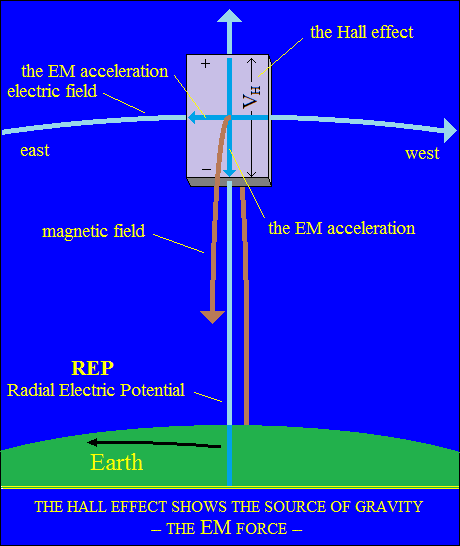-
Hall effect interpreted
vectorial
Structure of crystals.
The vector atom is composed of two vectorial currents (electric and magnetic),
that is surround orthogonally one on the other - the hydrogen atom.
Hydrogen atoms connect self their electrical and magnetic polarities,
forming the connecting currents and the atoms of the elements.
Elements atoms, through EM bonding currents, form stable crystalline
structures.
Interruption of the linking currents cause EM oscillations, switch or
remain open polarities.
Under certain conditions of formation, some crystals keep open electric
or magnetic polarities - magnets, electrets.
Voltage - propagation.
The variable magnetic field (Faraday's induction) interacts with the magnetic
circuits of the atoms
-
in the conductor and
produces EM force (voltage)
The EM force in the conductor (voltage) is a centripetal interaction,
which switches the connecting currents into the conductor axis, on the
domino principle - the propagation of the electric current.
Electrical current.
The switching of the atomic linking currents into the conductor axis forms
the electrical current.
Electrical resistance.
The linking currents oppose the switching in the conductor axis - the
electrical resistance.
Voltage and electrical resistance are contrary.
The intensity of the resistance forces depends on the distance between
the atoms in the crystal structure. There are crystals in which bonding
currents are easily switch
-
and others that cannot
be switching - insulators
Interactions between the EM force (voltage) and the forces of the bonding
electrical currents (the resistance)
produce EM oscillations - thermal and optical effects.
These EM oscillations also occur at the deformation or bending of the
conductor,
and consist of breaking the electrical linking current, with electric
arc.
-
Hall
effect
The magnetic induction field, applied perpendicularly to the plate and
the current,
-
produces EM force.
EM acceleration passes through the semiconductor plate at the speed of
light, pushes the atoms,
orients the electrical polarities in the direction of acceleration,
-
and produces electric
potential - the Hall effect.
Tangential:
The VH is unload through the metallic laterals
contacts of the current supply.
In the same kind, REP produces the solar activity.
So, punctually contacts are required, as the Bose made with the galena.
The Hall effect shows the source of gravity - the EM force.
The Hall effect is demonstrative for generating radial electrical potential
(REP):
The vector (electrical) current generated by the rotation of the earth
produces the planet's magnetism
and implicitly the EM centripetal interaction.
The centripetal acceleration polarizes the substance and results in the
radial electrical potential
- the Hall effect at the planetary level -

